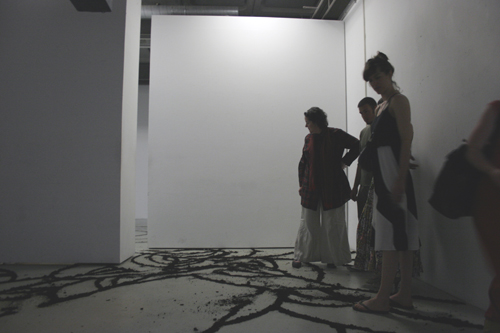
GTBT Start Introduction Itinary Outro

Polish artist Izabela Oldak made a site-specific installation in the project room. The mobile walls were moved to the centre of the space creating two different but corresponding rooms connected by a small opening. The artist made floor drawings of a spiral using ashes from Olkhon in the right space, and drawings of an organic pattern using earth from Enschede in the left room. The audience was invited to enter the space on the right and to go through the passage to the other side. There they could leave the room through the other door. The concept was to create a very symmetric space for the drawing as a whole, with two walls in the middle, two rooms of the same size, two open doors, and the space between.
Painting is at the core of Izabela Oldak's oeuvre, but the artist is always trying to break its boundaries and conditioning, e.g. the traditional figure-ground division. In this work the painting itself took the form of a ground that invited people –in other words human figures– to step on it. However the artist writes: 'It was my purpose to invite people to step through the drawing, a symbolic transition from life to death and vice versa, and in this act something needed to be sacrificed i.e. the drawings that I did.' [1] For many years this artist has pursued an exploration of patterns, ornaments and symbols. In this installation there was the form of a spiral which references death, and a pattern of stylized nature (roots, plant stalks symbolizing life and vitality) with a pulsating energy. Patterns, ornaments and symbols belong to folklore and local traditions, but the artist attributes a larger meaning to them; in her view the world as a whole resembles a complex mosaic with forms and formations that are in constant flux and of which we as humans are a part. Indeed, one final image that the work offered, was that of a group of viewers who stood in empty spaces – islands created by the vegetative patterns.
Though this work had been conceived at an early stage of the workshop, it was closely connected to the experience of the artist of the trip and the island, during which she realised a complex personal ritual that was intended to break the spell of the past, and cross the border of the present.[2] An important aspect of the work is that it was designed in the spirit of anticipated destruction. In reality the floor drawing evoked respect; it was as if the audience felt they were on holy ground.
2 In the train and on the third morning at Olkhon the artist realised a performance with a personal meaning. At its core was the attempt to cleanse herself of a negative past. In the train she painted symbols, patterns and ornaments in henna on her body, and she asked the other artists to do this on her body too. At the island she staged a ritual wherein the symbols, patterns and ornaments were symbolically removed from her body at sunset, through a baptism with water from Lake Baikal. Thus, also this work was an attempt to break on through to the other side; to another, perhaps transcendental, side of existence.

